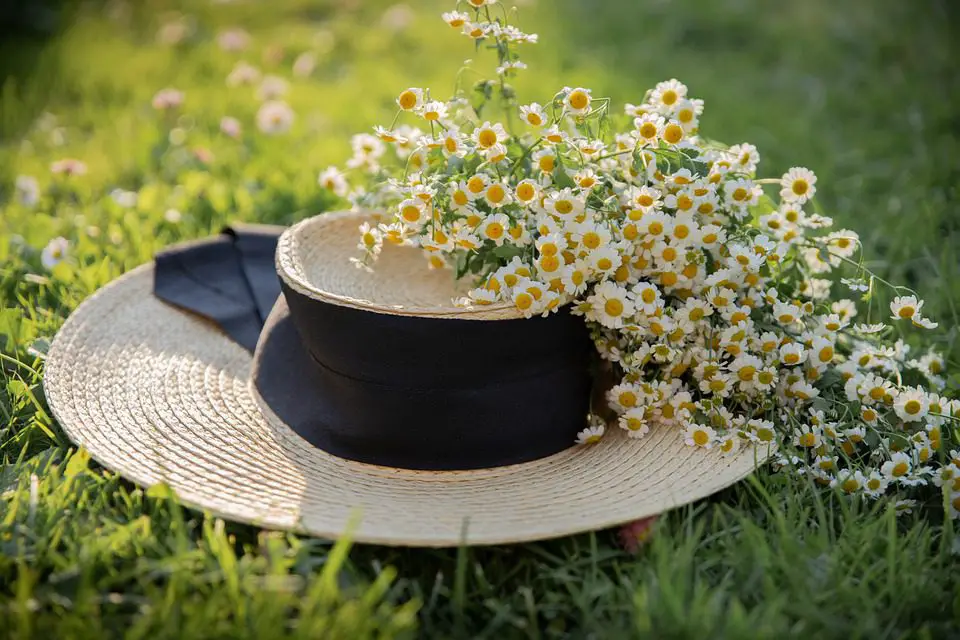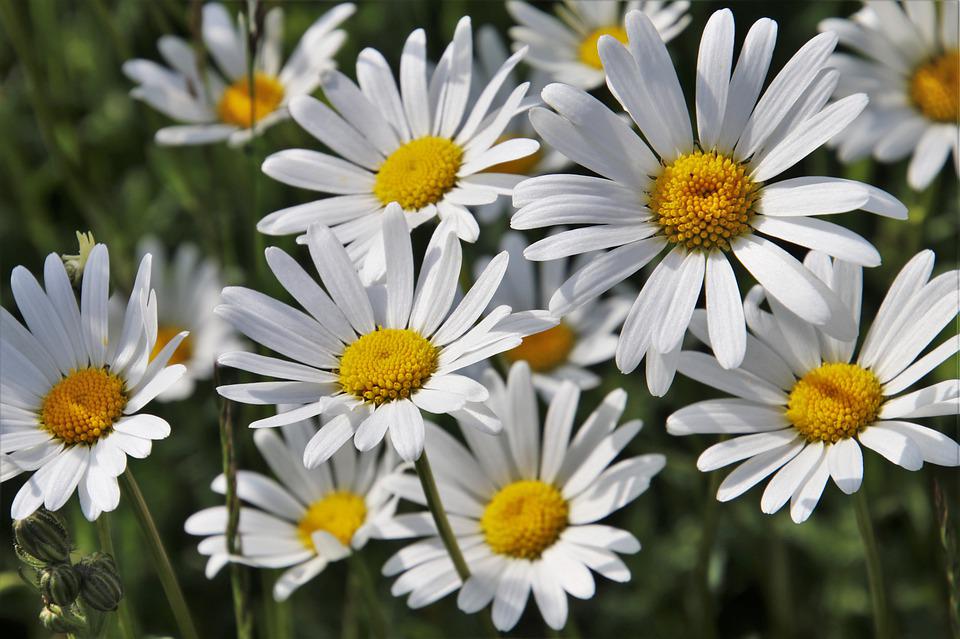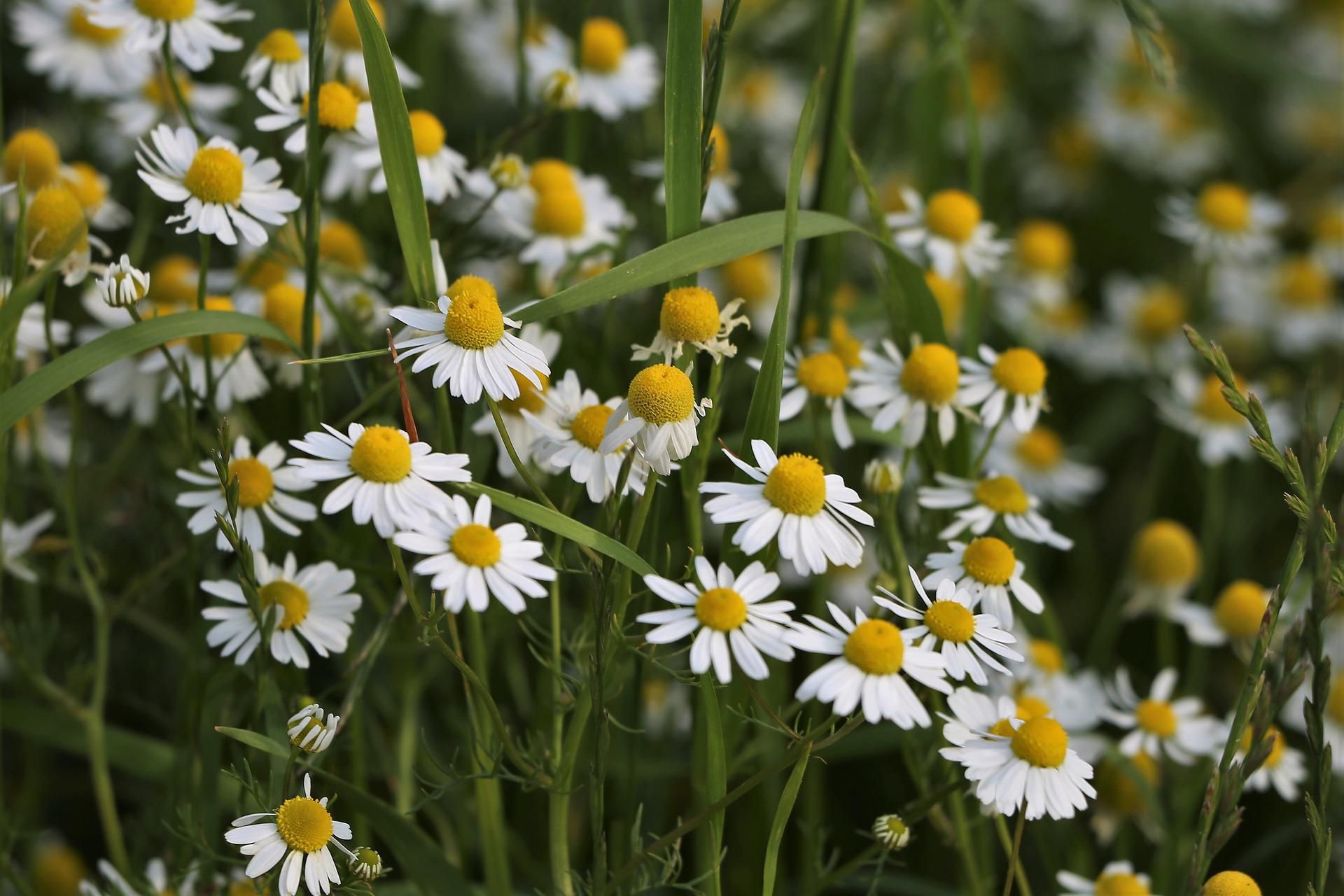
Last updated on May 20th, 2023 at 09:33 pm
Have you seen the chamomile flower? You can always find them as a group of flowers. These flowers may remind you of cute little girls in white and yellow dresses standing together. As a breeze comes, they all wave their heads and dance. They look so beautiful.
When you are introduced to a person, the first thing you learn about them is their name. Camomile flower or chamomile is the common name of this flower. They look like daisy flowers with large centers and many petals. These belong to the family Asteraceae. There are two types of chamomile flower: German chamomile (scientific name is Matricaria chamomilla) and Roman chamomile or Anthemis nobilis (scientific name is Chamaemelum Nobile).
German camomile or Matricaria chamomilla originated in Southern and Eastern Europe. But you can see them on almost all the continents. It has a smooth and vertical stem. Leaves are long and narrow. The flower has two parts white ray florets and yellow disc florets.
Chamomile is also called ground apple. Chamomile is derived from the old French Camomille, the late Latin chamomilla, and the Greek khamaimelon. Chamomile flower means earth apple or ground apple. The flowers have large apple-like round centers and have an aroma of apples.
These are annual plants, and flowers bloom in early to midsummer. It has a swollen receptacle, and there are no scales. A blue essential oil in the flowers gives them their characteristic aroma. Its common name is blue chamomile from this oil. It also has another name, “water of youth.”
Chamaemelum Nobile or Anthemis nobilis have many common names. Some of its common names are Roman chamomile, English chamomile, garden chamomile, ground apple, low chamomile, mother’s daisy, or Whig plant. You must have heard of these names. You can find them in dry fields, near gardens, and on cultivated grounds. Roman chamomile is originally from Asia and North Africa. Today, Europe, South America, and North America are the continents where you find Roman chamomile flowers the most.
Other chamomile varieties include Egyptian chamomile, yellow chamomile, Moroccan chamomile, and wild chamomile.
What does the Chamomile flower symbolize?

Chamomile flower meaning and symbolism are linked to calmness, rest, peace, and poise due to the herbs’ calming and soothing properties.
In different cultures, the white flowers are a symbol of renewal and rebirth. The wildflower’s ability to survive through hardships and bloom despite the wear and tear and trampling from the foot traffic connects it to energy and resilience.
Since ancient times the chamomile flower has also been associated with wisdom, ingenuity, sleepiness, patience, wealth, and love despite difficulties.
The healing powers of chamomile have been known since the Middle ages. These white flowers were hung in bunches from the door to ward off evil and as protection from the witches. Chamomile is believed to drive away negative energy.
With so many positive notes tagged to the Chamomile flower, it is said that placing potted Chamomile plants near the door or windows can prevent negativity from entering the house.
In ancient Egyptian culture, chamomile flowers were associated with the Sun god Ra and used to treat diseases like malaria. They were also used in the mummification process.
Chamomile flowers are also linked to Roman God Cernunnos and the Greek Sun God Helios. The connection may also have been drawn due to the flower’s sun-like appearance.
The sweet fragrance of the chamomile flower inspired the Romans to use them as incense. The Roman chamomile flower meaning does not have roots in ancient Roman culture. This variety derived its name from the fact that in the 19th century, a plant collector discovered some of these chamomiles growing on the ruins of a stadium in Rome.
All in all, the chamomile flower symbolic meanings are:
- humility
- rest
- peace
- poise
- calmness
- positivity
- happiness
- joy
Meaning of the Chamomile flower colors
White and Yellow color

Like most white flowers, the chamomile flower’s meaning is linked to purity, peace, enlightenment, poise, and calmness. These flowers are about positive emotions as they heal, cure, and soothe the body.
Chamomile flowers also symbolize a fresh start and rebirth. It is the symbolism of the fresh beginning of someone’s life and rebirth from past difficult experiences and grief. They can be gifted to someone to help them move forward from a period of grief.
The yellow heart symbolizes warmth and happiness. Yellow is the color of the sun and implies a new day.
Interesting facts about the Chamomile flowers
- In Germany, this popular herb is called ‘alles zutraut,’ which means ‘capable of anything.’
- Chamomile is used for various therapeutic purposes, such as boosting digestion, improving sleep, reducing stress, and relieving gas and nausea. This herb also has anti-inflammatory and antiseptic properties.
- Chamomile symbolizes good luck in several folk magic traditions, such as in South America. A chamomile garland is worn around the hair to attract a lover. Carrying some Chamomile flowers in the pocket is said to invite good fortune.
- Chamomile preparations are used topically to heal burns, cuts, skin rashes, and blisters.
- Chamomile mouthwash also improves oral health.
- Chamomile also finds use in cooking and drinks. In Spain, Chamomile is used for flavoring a light and dry sherry wine called Mantazilla.
- Anglo-Saxons used it for making beer until hops were used for the purpose.
- Dried flowers mixed with hot water make chamomile Tea. This herbal tea has many health benefits; they have an excellent anti-inflammatory effect and can alleviate cough and cold symptoms.
- Russia declared the Roman chamomile flower as the country’s native flower. Because they understood the Camomile Flower meaning. Russians use them as a form of predicting the future in the matter of love. They pluck each petal, saying, “he/she loves me, he/she loves me not,” alternatively. And they predict the future of love based on the last petal.
How to grow Chamomile flowers
Chamomile, an annual herb, blooms from late spring to early summer. It is, nevertheless, unique in that it constantly blooms throughout the summer and fall until frost stops it. It may stop blooming during periods of extreme heat. This is one of the characteristics that make it so popular as a grass substitute for lawns.
- Allow the chamomile to grow in either full sun or partial shade during hot climates.
- Plant them in nutrient-rich, organic soil.
- Water young chamomile plants about an inch per week.
- Allow plants to dry between light waterings.
How to care for Chamomile flowers
- Exposed chamomiles to direct, full sun to blossom.
- Maintain moisture in the soil until new growth appears.
- Trim the stem after the initial bloom harvest to promote fresh growth and greater flower output.
- Deadhead fading flowers to foster new buds.
Best time to gift Chamomile flowers

Chamomiles look quite similar to daisies. They have a strong apple-like scent, making them popular as freshly cut flowers. Chamomile flowers may not be a popular flower to give in a bouquet, but they are popular gifts given in the form of tea.
Understanding the meaning of chamomile flowers will help you know the best time to give them to someone.
If your loved one is stressed, and you want to comfort them, then give a dried chamomile flower.
If someone is going through a tough time, send fresh chamomile blooms. They will sense your love and support. Chamomile flowers can calm people’s strong distressing feelings.
A new career or a newborn baby brings happiness and responsibilities; a bouquet of chamomile flowers is an ideal gift.
Conclusion
These flowers may be available in dried form in every grocery shop, but they deserve to be appreciated for more than just soothing tea.
Chamomile fresh flowers are full of beauty and scent. They are among the most delicate and appealing daisy-like flowers to include in a bouquet. Even when dried, they can bring fragrance and beauty to any arrangement.
If you want to know and learn more about flowers, we at PansyMaiden can help you. Check out our fun, easy-to-read, and informative flower-related content that you will surely enjoy!
